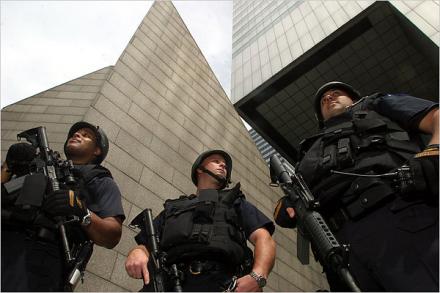 Counterterrorism teams like these city detectives armed with M-4 rifles will patrol the subways.
Counterterrorism teams like these city detectives armed with M-4 rifles will patrol the subways.
New York Times
February 2, 2008
New Operation to Put Heavily Armed Officers in Subways
By AL BAKER
In the first counterterrorism strategy of its kind in the nation, roving teams of New York City police officers armed with automatic rifles and accompanied by bomb-sniffing dogs will patrol the city’s subway system daily, beginning next month, officials said on Friday.
Under a tactical plan called Operation Torch, the officers will board trains and patrol platforms, focusing on sites like Pennsylvania Station, Herald Square, Columbus Circle, Rockefeller Center and Times Square in Manhattan, and Atlantic Avenue in Brooklyn.
Officials said the operation would begin in March.
Financing for the program will be funneled to the Police Department and will come from a pool of up to $30 million taken from $153.2 million in new federal transit grants to the state.
Michael Chertoff, the secretary of homeland security, and Gov. Eliot Spitzer announced the grants at a news conference on Friday at Grand Central Terminal, where Police Commissioner Raymond W. Kelly outlined his plans to add a layer of security to the city’s 24-hour transit system.
Mr. Kelly’s plan to heighten security and monitor a subway system that carries nearly five million people a day along 656 miles of tracks reflects the city’s continuing concerns about a possible attack.
After the Sept. 11, 2001, terrorist attack, police patrols increased in the subways, particularly at the entrances to the 16 underwater tunnels. As terrorists have hit rail systems around the world, the police in New York have reacted with strategies tailored to thwart similar attacks.
For instance, after the bombings of three trains and a bus in London on July 7, 2005, police officials in New York took steps to protect the city’s subways, including random inspections of train riders’ backpacks and packages, a program that continues today.
“New York remains at the top of the terrorist target list, and mass transit remains a concern because it has been targeted many times around the world,” Mr. Kelly said in a statement released by his chief spokesman, Paul J. Browne. “There have been several thwarted plots against New York’s subway system as well.”
Each team in the operation will comprise a bomb-sniffing dog and six officers: a dog handler and a sergeant and four officers from the Emergency Service Unit who will be outfitted in heavy, bullet-resistant vests and Kevlar helmets and will carry automatic weapons, either an M-4 rifle or an MP5 submachine gun.
The officers will work in shifts of 12 hours to provide as much coverage of the subway system as possible, Mr. Browne said.
Officers with high-powered rifles have patrolled sensitive sites above ground in New York, like the Empire State Building, and have guarded subway entrances after attacks in other cities, but have never made daily patrols. .
Michael A. L. Balboni, the state’s deputy secretary for public safety, said that since May, National Guardsmen armed with automatic rifles have patrolled the platforms of the PATH train system in New York and in New Jersey.
Mr. Balboni said that having heavily armed city officers routinely patrol the subways was an important first step.
But more broadly, he said, linking security plans for the disparate rail systems in the metropolitan region was “key in securing additional funding from the Department of Homeland Security.” He said that Mr. Chertoff praised the state for collaborating across geographic regions, since transit systems in New Jersey and Connecticut would also be affected.
“Going forward, the New York metropolitan transit system is getting a $50 million increase over last year’s funding for transit security,” Mr. Balboni said. “What we did was pull together eight agencies, three states and a multitude of police agencies to come up with regional funding priorities.”